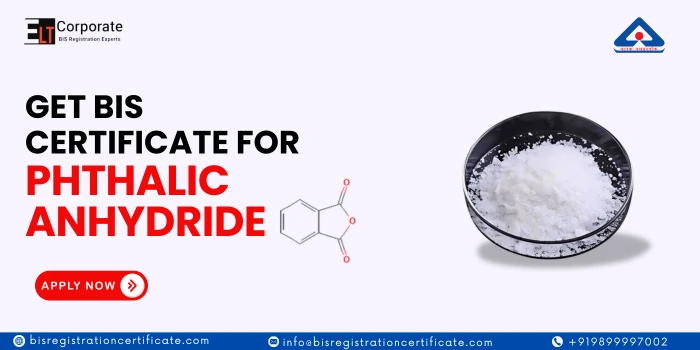BIS Certification for Phthalic Anhydride is crucial for manufacturers and importers looking to ensure their products meet the quality and safety standards set by BIS.
These days, it’s difficult to stand out in the market without having high-quality and certified products. So, if you want to sell Phthalic Anhydride in India you must obtain BIS certification as per IS 5158:1987.
Phthalic Anhydride is a key industrial chemical that produces various products, including plastics, resins, and dyes. This certification guarantees that the substance complies with the relevant Indian standards, ensuring safety, quality, and regulatory compliance.
In this article, you will learn about the significance of BIS Certification for phthalic Anhydride, the detailed certification process, the necessary documentation, and many more. Whether you’re a manufacturer, importer, or distributor, understanding BIS registration will ensure that your products meet the highest standards of safety and quality as per 5158:1987.
Required Tests And Packing Specifications For Phthalic Anhydride IS 5158:1987
To ensure compliance with the prescribed standards, the following tests must be conducted on phthalic anhydride:
- Crystallizing Point: This test determines the temperature at which phthalic anhydride crystallizes. It helps in assessing the purity of the chemical.
- Colour of the Molten Material: The colour of the molten phthalic anhydride is checked to ensure it meets the specified colour requirements.
- Free Acidity: This test measures the level of free acidity in the phthalic anhydride, which is critical for maintaining the chemical’s quality and stability.
- Maleic Anhydride & Other Oxidisable Impurities: The presence of maleic anhydride and other oxidizable impurities is evaluated to ensure they are within acceptable limits.
- Ash Content: This test determines the amount of ash residue left after the sample is burned, which helps in assessing the purity of the phthalic anhydride.
- Iron Content: The level of iron in the phthalic anhydride is tested to ensure it is within the allowable limits, as excess iron can affect the quality of the chemical.
- Naphthalene Content: The amount of naphthalene present is checked to ensure it is within the specified limits.
Packing And Marking Of Phthalic Anhydride IS 5158:1987
Packing and marking of Phthalic Anhydride must adhere to the specifications outlined in IS 5158:1987. Key points include:
- Standard Mark (ISI Mark): Each container of phthalic anhydride must display the ISI Mark, indicating that the product meets all specification requirements. To use this mark, the manufacturer must obtain a BIS license from the Bureau of Indian Standards.
- Labelling: Each container must be labelled with information as specified in the standard, which includes details such as the product name, manufacturer’s information, and any other relevant data.
Manufacturers must obtain a BIS license by demonstrating that their manufacturing infrastructure, quality control procedures, testing capabilities, and production processes meet BIS standards. This license is essential for legally using the ISI Mark on the product.
Mandatory Documentation Required To Get BIS Certification For Phthalic Anhydride
To obtain BIS certification for Phthalic Anhydride, manufacturers must submit the following essential documents as part of the certification process:
- Application Form: A fully completed application form, detailing the manufacturer’s information, product specifications, and manufacturing processes.
- Manufacturing Infrastructure Details: Documents outlining the manufacturing facility’s layout, machinery specifications, and production capacity.
- Quality Control Measures: Detailed records of the quality control systems in place, including quality assurance protocols, testing procedures, and compliance with a Quality Management System (QMS).
- Testing Capabilities: Information on the manufacturer’s in-house testing facilities or proof of arrangements with BIS-approved laboratories for product testing.
- Production Process Description: A comprehensive description of the Phthalic Anhydride production process, covering raw materials, manufacturing stages, and key quality control checkpoints.
- Product Samples: Manufacturers may need to provide samples of Phthalic Anhydride for testing at BIS-approved laboratories to ensure conformity with the relevant standards.
- Legal and Statutory Documents: Copies of key legal documents such as the company’s incorporation certificate, GST registration, and any required licenses or permits.
Note: Specific requirements for document submission may vary based on BIS regulations for Phthalic Anhydride. Manufacturers should ensure all documents are accurate and complete to facilitate a smooth certification process.
How To Obtain BIS Certification For Phthalic Anhydride?
To get BIS certificate for Phthalic Anhydride, manufacturers must follow this step-by-step process:
- Submit Application: First things first, you’ll need to fill out an application form and send it to BIS with all the necessary details about your product and how you make it.
- Document Review: BIS will go through the documents you’ve provided, like information about your factory, quality checks, and how you test your product.
- Factory Inspection: Next, BIS might want to visit your factory. They’ll come in and check out your equipment, how you make Phthalic Anhydride, and whether everything is up to their standards.
- Sample Testing: You may need to send them samples of Phthalic Anhydride for testing in one of their approved labs, just to make sure your product meets their safety and quality standards.
- Evaluation and Assessment: Once the tests are done and everything checks out, BIS will take a final look at your quality control processes, testing methods, and overall product quality.
- Issuance of License: If all goes well, BIS will give you the certification, allowing you to use the ISI mark, which shows your product is up to standard.
Manufacturers must adhere to BIS guidelines, provide accurate documentation, and ensure full compliance with standards throughout the process for successful certification.
What Happens If I Don’t Get BIS Certification For Phthalic Anhydride?
Failing to obtain BIS certification for Phthalic Anhydride can lead to several challenges. Without certification, your access to the market may be restricted, as many customers prefer certified products that meet safety and quality standards.
Additionally, it may be harder to comply with regulatory and government policies, putting your business at a disadvantage. Competitors who have the certification will have a clear edge, being able to promote their products as certified and trustworthy.
To overcome these issues, it’s important to evaluate the reasons behind the failure, address any shortcomings, and improve product quality and compliance.
For expert assistance in navigating the certification process, you can contact ELT Corporate Pvt. Ltd. at +91 98999 97002 or email info@bisregistrationcertificate.com. We specialize in BIS certification and ensure your product meets the required standards.
What Is The BIS For Phthalic Anhydride?
The BIS certification for phthalic anhydride is 5158:1987. The BIS Certificate for Phthalic Anhydride is an official recognition from the Bureau of Indian Standards that the product meets Indian safety and quality standards.
What Is The Classification Of Phthalic Anhydride?
Phthalic Anhydride is an organic chemical classified as an anhydride of phthalic acid. It is mainly used as a chemical intermediate in producing plastics, resins, dyes, and pigments. Its CAS number is 85-44-9.
Which Is The Largest Producer Of Phthalic Anhydride In India?
IGPL is one of the largest producers of Phthalic Anhydride (PAN) at a single location, meeting international standards.
Why Is BIS Certification Necessary For Phthalic Anhydride?
A BIS certificate is necessary for Phthalic Anhydride as it guarantees product safety, and facilitates market entry.








